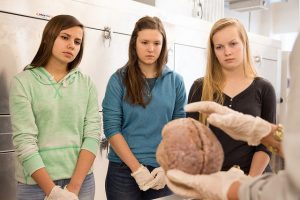Verizon Grant to Expand DMPS-DMU Partnership
The Verizon Foundation annually provides $20,000 Innovate Learning Awards to as many as 50 U.S. schools to support increased STEM learning in K-12 schools.
One of the chosen schools this year is Central Campus in Des Moines, more specifically the school’s “Brain Histology STEM Lab,” an initiative that will get underway next fall.
The project will actually represent an extension of a longstanding alliance between DMPS and Des Moines University. Already students in the College Anatomy & Physiology program at Central regularly visit the DMU facilities right up the street on Grand Avenue. Sometimes they’re in the Evolving Brain Laboratory established by Dr. Muhammad A. Spocter, working on the Canine Brain Project, a program focused on what makes dogs tick and exploring the use of canines in animal-assisted therapy.
Other times, like first thing Thursday morning, they get to learn at the DMU cadaver lab.
Prior to receipt of the Verizon grant Kacia Cain’s students were assigned to design and propose research projects as part of their challenging coursework. Now, thanks to the additional funding secured by DMPS grant writer Cassaundra Christensen in collaboration with Spocter and Cain, they’ll get to follow through and actually do what they propose.
This new development is just the latest notch on Cain’s resume. The Iowa Academy of Sciences recognized her in 2013 as one of the top science teachers in the state, one of six educators that year to receive the Excellence in Science Teaching Award.
She also sits on the Executive Committee of the governor’s Iowa STEM Advisory Council along with college presidents and corporate CEOs.
Cain has taught at Des Moines Public Schools for more than 20 years. She currently teaches the following courses at Central Campus: College Anatomy and Physiology; College Biotechnology; College Biological Research in Neurosciences; and Health Sciences Anatomy. Can a high school teacher be promoted to the rank of Professor? Wait, she is an adjunct prof at DMACC!
She forged the partnership with DMU that presents extremely advanced and rare opportunities for exceptionally qualified local high school students.
Dr. Donald Matz, DMU anatomist, is a longtime associate of Cain’s and he led her A&P class on a tour of the DMU campus Thursday morning that culminated in the cadaver lab. But before the students got their hands on dead patients they got a glimpse of what it’s like when first-year medical students have to begin actually touching and interacting with live ones. Dr. Matz explained that DMU brings in actors to role-play as patients and enable students to practice their diagnostic skills and bedside manners. And in the mock ER setting there is a computerized SIM-patient. Sometimes he “crashes and burns,” Dr. Matz said, just like real patients do. “You have to learn how to deal with families as well as patients in medicine.”
Before the cohort of future doctors was permitted into the cadaver lab Dr. Matz stressed to them the importance of being respectful.
“We have over 2,500 living body donors right now,” he said. “They have willed their bodies to DMU to serve an important purpose after their deaths.” This organic sort of endowment is part of the lifeblood of medical schools.
The students were also cautioned about the possibility they might feel squeamish in the presence of the cadavers and the scent of formaldehyde. But none reacted that way. On the contrary, gloving up and examining hearts, lungs, livers and other viscera brought human anatomy and physiology to life.
In small groups students rotated amongst tables staffed by Dr. Matz, a couple of current DMU students and Cain who slipped into the uniform of one of Dr. Matz’s lab coats. Their subjects ranged in age from late-forties to mid-nineties and presented an assortment of causes of death including vascular disease, cancer, Alzheimer’s, ALS and kidney failure.
The opportunities Cain offers students outside of her classroom help them explore hunches they might have about their futures and are a vivid fulfillment of the DMPS mission statement: The Des Moines Public Schools Exist So That Graduates Possess the Knowledge, Skills and Abilities to Be Successful at the Next Stage of Their Lives.
“I’ve had students who came away from this type of experience convinced they were meant to become doctors,” she said. “On the other hand, there was one time when someone turned pale and collapsed in the cadaver lab.”
“You can often tell a lot about your patient just by looking in their eyes,” Dr. Matz told the teens. Teachers might say the same of their students. Only a handful of Cain’s raised their hands when Dr. Matz asked how many plan on medical school. But the faces ringing the tables and probing the former somebodies now reduced to just some bodies were unanimously enthralled. With wide eyes and a broad smile one girl who was making Blizzards at DQ last summer examined a kidney that was an anonymous old man’s undoing. She looked extremely alive. Her prognosis is promising.
Undoubtedly the Verizon grant money will be well-spent, considering everything that’s been accomplished without it. There may even now be people out there who were cured by practitioners whose medical training began in Des Moines – in high school.





